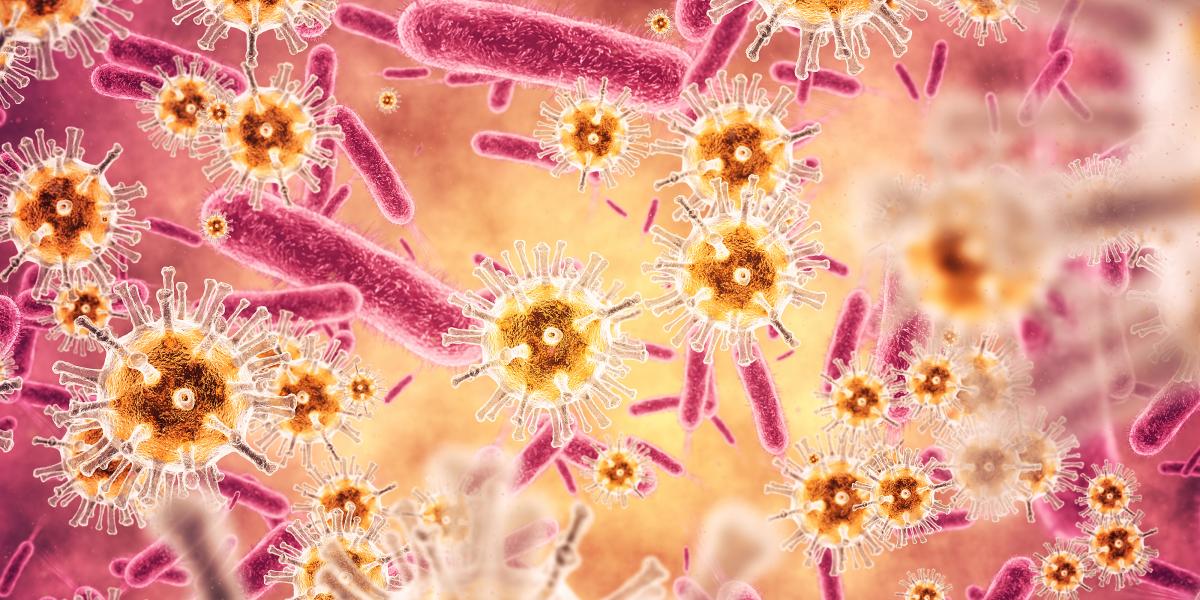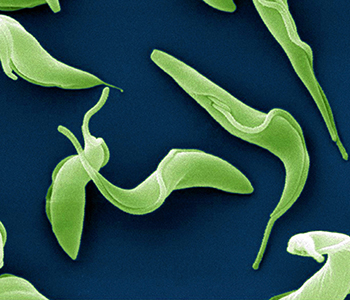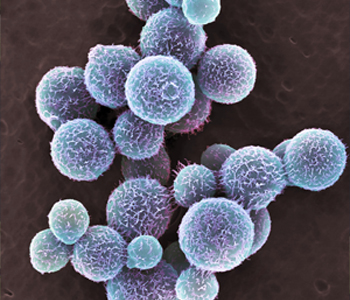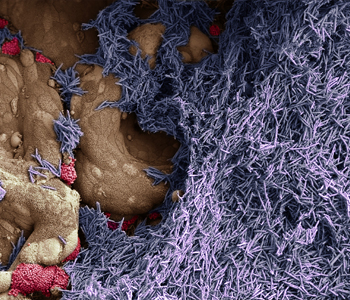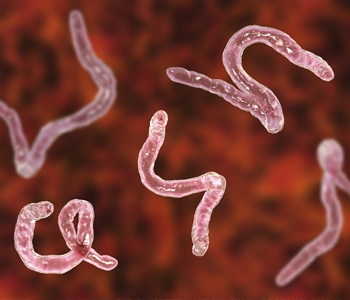Prioritizing Pathogens: Public Health in the Lab
Four Bloomberg School researchers investigate lesser-known microbes to identify their weapons and weaknesses—as well as new drug and vaccine targets.
T. brucei: Master of disguise
Trypanosoma brucei may cause sleeping sickness, but its machinery is pure hyperactivity. The parasite, carried by the tsetse fly in sub-Saharan Africa, constantly modulates its genetic expression and mutates so that, at any moment, a population of the parasite displays hundreds of different surface proteins. By the time a host’s immune system has zeroed in on T. brucei, it’s already put on a new disguise.
Not only does T. brucei evolve “a near infinite repertoire of coats it can wear to evade detection,” but it does so at a shockingly rapid, nonstop pace, says Monica Mugnier, PhD, an assistant professor in Molecular Microbiology and Immunology who studies the parasite. This has implications for the sensitivity of diagnostic tests, which currently rely on detecting antibodies for only a few specific surface proteins. It also suggests a strategy for treatment: targeting the machinery that lets T. brucei generate protein coats.
Mugnier’s lab has also learned that the parasite seems to use the spaces between cells within organs as its personal garment district, establishing its protein coat workshops in “dark alleys” where the parasite can dive in for a quick change. If researchers could find a way to block T. brucei from entering and setting up its machinery, “it won't be able to avoid the host immune system and maintain an infection.”
Although fewer than 900 people were infected by T. brucei in 2021, according to the WHO, livestock infections account for annual losses of $4.5 billion.
C. neoformans: Protected by pigment
Unlike most fungi, the environmental yeast Cryptococcus neoformans is one of the few that can survive at human body temperatures. For now.
As fungi worldwide adapt to global warming, however, scientists predict a surge in human infections. When C. neoformans manages to invade and persist in a human body, it can lead to cryptococcal meningitis, which kills more than 100,000 people each year, often HIV patients.
Making matters worse, fungal pathogens in general are not well studied and frequently come with extreme treatment challenges like drug resistance. In October 2022, the WHO listed C. neoformans at the top of its first-ever fungal priority pathogen list.
“I have been surprised by how complex and resilient C. neoformans is,” MMI postdoc Daniel Smith says. “At first, it seems like C. neoformans is a simple round yeast, but there are so many interesting and complex processes it is capable of.”
Smith and colleagues in Arturo Casadevall’s lab developed a timelapse microscopy technique to investigate how C. neoformans and other fungi establish infections in insect models. The key is how they produce melanin—the same pigment found in human hair and skin. In humans, fungal melanin dampens the immune response, allowing the fungus to survive, while the opposite happens in insects. Smith says studying this process in insect models may apply to finding new treatments to reduce the instances and severity of fungal disease in humans.
C. rodentium: A bacterium’s cancer connections
Bad lettuce might seem like a minor problem compared to, say, a global pandemic. But the next time you’re tempted to wave off a recall and take your chances with E. coli, consider this: Short diarrheal infections may cause genetic damage leading to colon cancer or colitis.
That’s what Biochemistry and Molecular Biology professor Fengyi Wan, PhD, and colleagues found in a study last year in Cancer Discovery. Wan’s lab studied how mice developed colon cancer after a bout with Citrobacter rodentium, the rodent analog of Escherichia coli. Mice are inherently resistant to human pathogenic E. coli, but C. rodentium shares about 67% of E. coli’s genes and most of its pathogenic mechanisms.
The researchers discovered that a specific protein secreted by C. rodentium during infection helped predict the number of tumors a mouse with colon cancer later developed. Now, Wan says his lab is working on developing small molecular inhibitors that will prevent genomic damage during C. rodentium/E. coli infections.
Diarrhea is common: The CDC estimates about 79,420 cases of E. coli-induced diarrhea in the United States annually, and globally it accounts for 9% of deaths among children under five. With colon cancer on the rise among younger adults, being able to prevent damage during E. coli infections could have an outsized impact on public health.
Parasitic helminths: Friends or foes?
Hookworm, whipworm, and Ascaris: “These are the unholy trinity of helminth infections,” says MMI professor Alan Scott.
Scott, PhD, MS, studies soil-transmitted helminths—a.k.a. parasitic nematodes, or roundworms—that take up residence in the lungs before making their way to the intestinal tract. Together, the unholy trinity infects about 800 million to 1 billion people at any given time. Severe infections can cause anemia, iron deficiency, stunted growth, and cognitive delays. The only solution is a handful of available deworming drugs, for which Scott says “the signature of drug resistance is starting to show its ugly head.”
His lab investigates molecules that parasitic helminths produce and release, some of which seem to render a host’s immune system unable to evict its wriggling squatters. The lab is testing these molecules one by one and also looking for patterns in how they work in concert to dampen various immune mechanisms.
More than informing new drug formulations for people in underdeveloped countries, this work has implications for understanding what the developed world might inadvertently be missing. After all, Scott says, prior to widespread use of modern sanitation arguably every human had experienced at least one worm hitchhiker in their lifetime. He speculates that, for eons, these infections had profound impacts on the normal human microbiome, including how we respond to environmental allergens and develop autoimmune diseases.
“We can probably eradicate [human helminth infections], but I don’t know if that’s necessarily a good thing,” he says. “Maybe low-level infections might be beneficial to some extent.”
